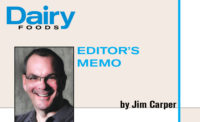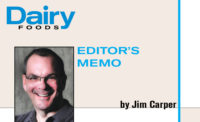
What if there were data on consumer thoughts about every hot issue in the dairy industry? And what if we had tracked opinions across several years? It would be a treasure trove for strategic planning and marketing.
Well, we have.
Or more accurately, Dairy Farmers of Wisconsin has. The “check-off” marketing leader in Wisconsin began surveying consumers in 2006 and beefed up the questioning in 2013 to unlock not only consumer perceptions, but also trends across time.
This biennial survey of about 300 random Wisconsinites shows some favorable biases toward dairy. But perhaps more importantly, trends appear that need dairy’s attention. Because if you unearth a negative attitude about dairy in the heart of America’s Dairyland, you can bet you’ve found a real hot button.
Let’s start with plenty of good news: Dairy is named as the industry with the most impact on the state — doubling votes received by second place “health care.” Consumers self-identifying as active supporters of the dairy industry rose from 64% in 2015 to 73% in 2021. Likewise, based on answers to a lengthy set of questions, 52% of consumers in 2021 could be categorized as “heavy cheeses users,” and 50% as “Wisconsin cheese lovers.”
So, you know, cheeseheads.
And while phrases such as “I am proud to call Wisconsin the dairy state” hover around 90% acceptance across 15 years of data from randomly picked consumers, other phrases such as “Wisconsin dairy farmers treat cows humanely” slipped from 84% agreement to 78% in the last two years. And when a subset of “non-active supporters” is teased from the data, the statement “Animals treated humanely is important to Wisconsin dairy” was supported by just 51% in 2021 — down nearly 20 points in two years.
The trend is telling. In 2021, a rather strong 77% of all surveyed agreed that “Wisconsin has a long history of environmental stewardship;” yet that question had reached 85% agreement in 2015. Fewer Wisconsinites agreed with the phrase “Wisconsin dairy is NOT a threat to water quality.” Support fell over 10 points to 36% agreement in 2021.
At the same time, there’s good news in the environmental issues probed by the survey. The statements “Wisconsin dairy is a leader in protecting the environment” and “Wisconsin dairy is a leader in producing bio-energy” rose in acceptance in the 2021 polling.
When survey answers are clumped into categories, the economic importance dairy and the nutritional benefit of dairy foods clearly drive positive feelings toward the dairy industry. Meeting challenges around environmental issues and animal welfare have the most potential to lift dairy support even further. And these data can reveal consumers’ reactions to dairy’s efforts through time.
Wisconsin dairymen are building watershed groups to monitor and reduce runoff into local waters, backed by science and assistance from groups such as Wisconsin Discovery Farms and Farmers for Sustainable Food. They’re adding digestors to create green energy, and they’re taking better care of their animals than at any other time in history. This treasure trove from Dairy Farmers of Wisconsin reveals that educating consumers — telling the true story of modern dairy farming — is as crucial as these on-farm efforts.
Dairy has a strong foundation of support, but we must market as well as we make.
John T. Umhoefer is executive director of the Wisconsin Cheese Makers Association.



